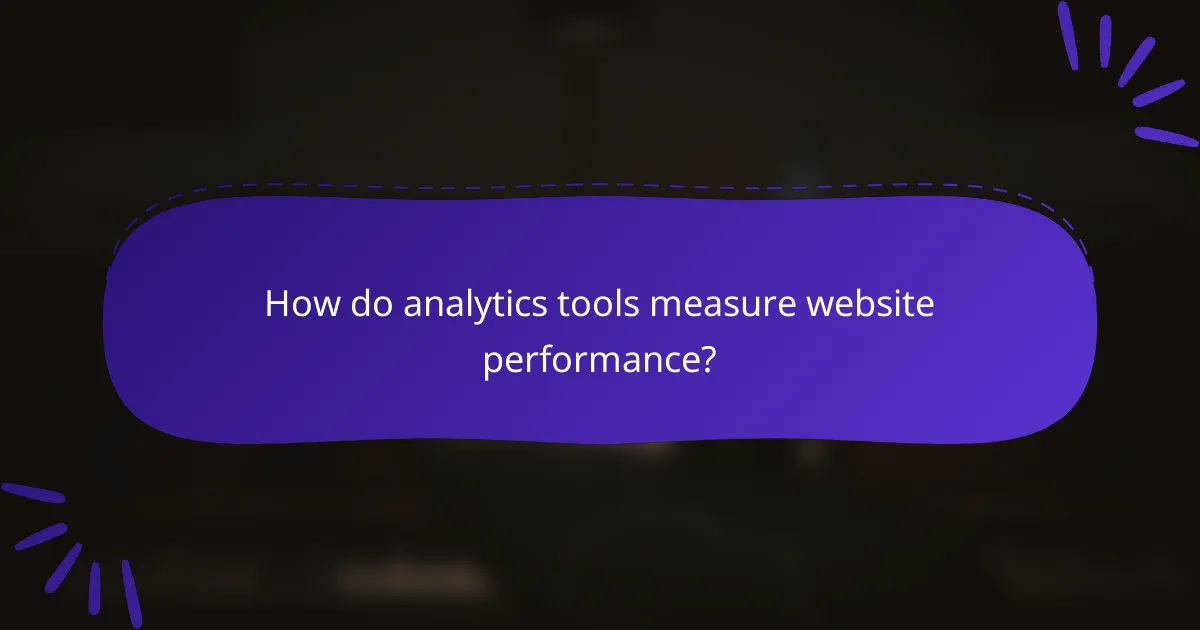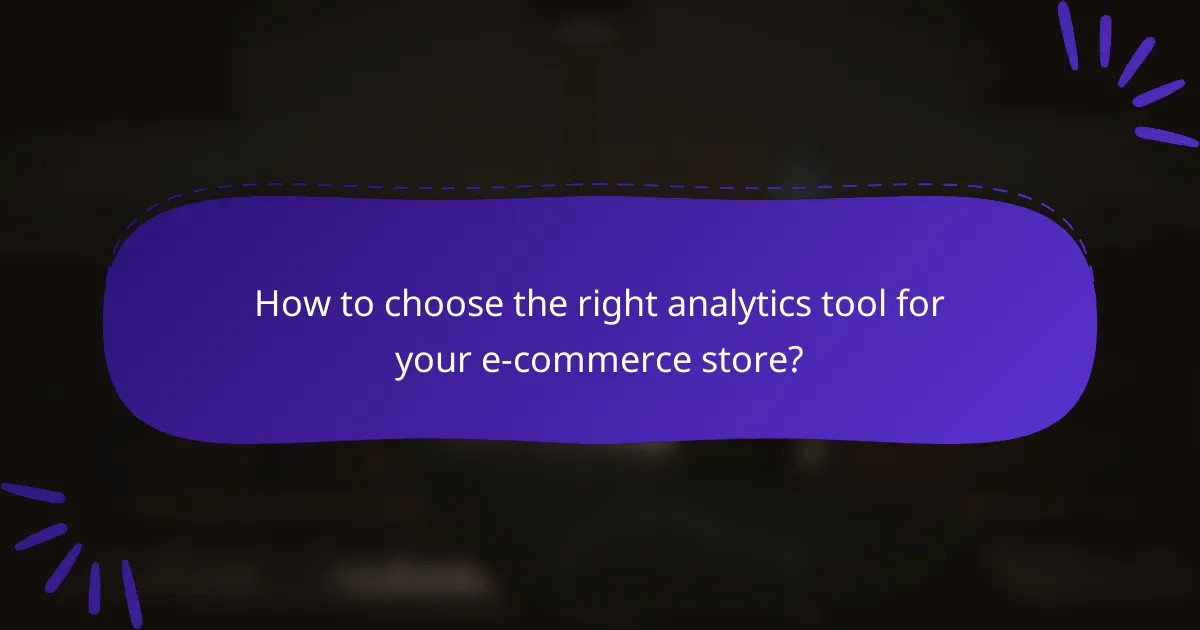Analytics tools are essential for e-commerce businesses, enabling them to track performance, understand customer behavior, and optimize marketing strategies. By measuring website performance through data analysis, these tools provide valuable insights that enhance decision-making and improve customer experiences. With options like Google Analytics 4 and Adobe Analytics, businesses can tailor their approach to meet specific needs and drive growth.

What are the best analytics tools for e-commerce?
The best analytics tools for e-commerce help businesses track performance, understand customer behavior, and optimize marketing strategies. Key options include Google Analytics 4, Adobe Analytics, Mixpanel, Heap Analytics, and Matomo, each offering unique features tailored for e-commerce needs.
Google Analytics 4
Google Analytics 4 (GA4) is a powerful tool that provides insights into user interactions across websites and apps. It uses event-based tracking, allowing businesses to measure specific actions like purchases and page views more effectively than previous versions.
GA4’s machine learning capabilities can predict user behavior, helping e-commerce sites identify trends and opportunities. It’s essential to set up conversion tracking properly to gain actionable insights, and users should familiarize themselves with the new interface to maximize its potential.
Adobe Analytics
Adobe Analytics offers advanced features for e-commerce analytics, focusing on real-time data and customer segmentation. It allows businesses to create detailed reports and dashboards tailored to specific goals, such as increasing sales or improving customer retention.
One of its strengths is the ability to integrate with other Adobe products, enhancing marketing efforts. However, it may require a steeper learning curve and higher investment compared to other tools, making it suitable for larger organizations with more complex needs.
Mixpanel
Mixpanel specializes in product analytics, providing deep insights into user engagement and retention. It tracks events and user actions, allowing e-commerce businesses to analyze how customers interact with their products over time.
Mixpanel’s cohort analysis feature helps identify user groups based on behavior, which can inform targeted marketing strategies. While it’s excellent for understanding user journeys, it may not provide as comprehensive a view of overall website traffic as other tools.
Heap Analytics
Heap Analytics automatically captures every user interaction on a website without requiring manual event tracking setup. This feature allows e-commerce businesses to analyze data retroactively, making it easier to understand customer behavior without extensive configuration.
Heap’s visual interface simplifies data exploration, but users should ensure they define key metrics and goals to avoid data overload. It’s particularly useful for teams that want to quickly gain insights without heavy technical resources.
Matomo
Matomo (formerly Piwik) is an open-source analytics platform that provides full control over data privacy and ownership. It’s a great option for e-commerce businesses concerned about data compliance and security, as it can be hosted on-premises or in the cloud.
Matomo offers features similar to Google Analytics, including heatmaps and session recordings, which can enhance user experience analysis. However, it may require more technical expertise to set up and maintain compared to cloud-based solutions.

How do analytics tools measure website performance?
Analytics tools measure website performance by collecting and analyzing data related to user interactions, traffic sources, and conversion rates. This information helps businesses understand how effectively their websites engage visitors and achieve desired outcomes.
Traffic analysis
Traffic analysis involves monitoring the number of visitors to a website and identifying their sources, such as organic search, paid ads, or social media. Tools like Google Analytics provide insights into metrics such as page views, unique visitors, and session duration, allowing businesses to gauge the effectiveness of their marketing efforts.
To optimize traffic, focus on improving SEO strategies, enhancing ad targeting, and leveraging social media campaigns. Regularly review traffic patterns to identify trends and adjust your strategies accordingly.
User behavior tracking
User behavior tracking examines how visitors interact with a website, including which pages they visit, how long they stay, and their navigation paths. Heatmaps and session recordings are common tools that visualize user engagement and highlight areas for improvement.
Understanding user behavior can help identify obstacles in the user journey, such as confusing layouts or slow-loading pages. Use this data to refine user experience, ensuring that visitors can easily find what they need and complete desired actions.
Conversion rate optimization
Conversion rate optimization (CRO) focuses on increasing the percentage of visitors who complete a desired action, such as making a purchase or signing up for a newsletter. This process involves analyzing user data and testing different website elements, like call-to-action buttons and landing page designs.
To effectively optimize conversion rates, conduct A/B testing to compare variations and determine which performs better. Aim for incremental improvements, as even small changes can significantly impact overall conversion rates. Regularly review and adjust your strategies based on performance data to maximize results.

What insights can e-commerce businesses gain from analytics?
E-commerce businesses can gain valuable insights from analytics that help improve decision-making and enhance customer experiences. By analyzing data, businesses can identify trends, optimize operations, and tailor marketing strategies to meet customer needs.
Customer segmentation
Customer segmentation involves dividing a customer base into distinct groups based on shared characteristics. This allows e-commerce businesses to tailor their marketing efforts and product offerings to specific demographics, such as age, location, or purchasing behavior.
For example, a retailer might find that customers aged 18-24 prefer certain product categories, enabling targeted promotions. Using analytics tools, businesses can track customer interactions and refine segments over time, ensuring marketing strategies remain relevant.
Sales forecasting
Sales forecasting uses historical data and market trends to predict future sales performance. Accurate forecasting helps e-commerce businesses manage inventory, allocate resources, and plan marketing campaigns effectively.
Businesses can employ various methods, such as time series analysis or regression models, to estimate sales. A common approach is to analyze seasonal trends, which can help anticipate demand spikes during holidays or special events.
Marketing campaign effectiveness
Evaluating marketing campaign effectiveness involves measuring the impact of promotional efforts on sales and customer engagement. Analytics tools can track metrics such as conversion rates, click-through rates, and return on investment (ROI).
For instance, an e-commerce business might analyze the performance of an email marketing campaign by comparing sales before and after the campaign launch. This data helps identify successful strategies and areas for improvement, guiding future marketing initiatives.

How to choose the right analytics tool for your e-commerce store?
Selecting the appropriate analytics tool for your e-commerce store involves understanding your specific needs, including scalability, integration, and usability. A well-chosen tool can provide valuable insights that drive optimization and enhance customer experience.
Consider scalability
Scalability is crucial when choosing an analytics tool, as your e-commerce store may grow significantly over time. Look for tools that can handle increasing amounts of data and users without a drop in performance.
For example, if you anticipate doubling your product range or customer base within a year, ensure the analytics tool can accommodate that growth. Tools that offer tiered pricing plans or flexible data limits are often good choices.
Evaluate integration capabilities
Integration capabilities determine how well your analytics tool can work with other systems, such as your e-commerce platform, CRM, and marketing software. A tool that seamlessly integrates with your existing technology stack can save time and reduce errors.
Check if the analytics tool supports popular platforms like Shopify, WooCommerce, or Magento. Additionally, consider whether it can connect with email marketing services or social media platforms to provide a comprehensive view of customer interactions.
Assess user-friendliness
User-friendliness is essential for ensuring that your team can effectively utilize the analytics tool. A complicated interface can lead to underutilization and missed insights.
Look for tools with intuitive dashboards and clear reporting features. Free trials or demos can help you gauge usability before committing. It’s also beneficial to choose tools with strong customer support and training resources to assist your team in getting the most out of the software.

What are the key metrics to track in e-commerce analytics?
Key metrics in e-commerce analytics include average order value, customer lifetime value, and cart abandonment rate. Tracking these metrics helps businesses understand customer behavior, optimize marketing strategies, and improve overall profitability.
Average order value
Average order value (AOV) measures the average amount spent by customers per transaction. To calculate AOV, divide total revenue by the number of orders during a specific period. For instance, if your store generated $10,000 from 200 orders, your AOV would be $50.
Increasing AOV can be achieved through strategies like upselling, cross-selling, or offering bundle deals. Aim for a gradual increase in AOV by testing different approaches and monitoring their impact on sales.
Customer lifetime value
Customer lifetime value (CLV) estimates the total revenue a business can expect from a single customer throughout their relationship. To calculate CLV, multiply the average purchase value by the average purchase frequency and the average customer lifespan. For example, if a customer spends $100 per purchase, buys twice a year, and stays for five years, their CLV would be $1,000.
Understanding CLV helps businesses allocate marketing budgets effectively and identify high-value customers. Focus on enhancing customer experiences to increase retention and ultimately boost CLV.
Cart abandonment rate
Cart abandonment rate indicates the percentage of shoppers who add items to their cart but do not complete the purchase. To calculate this rate, divide the number of completed transactions by the number of initiated checkouts and subtract from 100. A typical cart abandonment rate can range from 60% to 80% across various industries.
Reducing cart abandonment can involve strategies such as simplifying the checkout process, offering free shipping, or sending follow-up emails to remind customers of their abandoned carts. Regularly analyze your cart abandonment rate to identify trends and areas for improvement.


